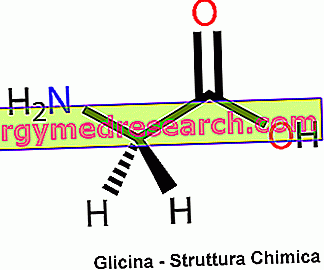Generalities and Features
Glycine (abbreviated Gly or G, brute formula NH 2 CH 2 COOH) is the smallest of the 20 ordinary amino acids (the one with the lowest molecular weight among the amino acids most present in proteins).
In fact, the

The crystallized glycine is solid, colorless and with a sweet taste.
Glycine in food
Glycine is an almost ubiquitous protein element, even if in not very high percentages; making up part of the collagen, present in the connective tissues and in the epithelia, most meat foods should contain a good amount. Furthermore, the glycine content also appears significant in various products of vegetable origin.
According to the nutritional tables consulted, the 5 foods richest in glycine are: whitefish (4.4g / 100g), soy protein, spirulina algae, cod and powdered egg white.

Soy ( Glycine max ) is one of the foods with the highest Glycine content
Not being ordinary foods, we also mention the foods richest in glycine among the most consumed: pork belly, mortadella, brisket, cooked cuttlefish, cooked chicken, veal breast, cooked octopus and pumpkin seeds (the latter 1, 8g / 100g).
Glycine Food Additive
Glycine is also a food additive for foods intended for human and animal nutrition.
In particular, glycine and its sodium salt are exploited as flavor enhancers (E640) and sweeteners, or as an improvement of pharmacological absorption.
Many dietary supplements and protein drinks contain added glycine.
Glycine and Aging
Topical treatment with glycine can help to reverse the defects associated with the aging of human fibroblasts (cells responsible for collagen production).
It has recently been discovered that the two CGAT and SHMT2 genes regulate mitochondrial activity and influence deterioration.
In an in vitro study conducted for 10 days, the addition of glycine to fibroblasts (obtained from cells belonging to a 97-year-old human being) determined the restoration of mitochondrial function and of the fibroblasts themselves.
In practice, by modifying the regulation of these genes by administering glycine, the researchers were able to restore the mitochondrial function of fibroblasts, to the benefit of collagen synthesis.
Medical Applications of Glycine
An article in 2014 noted that glycine can improve sleep quality.
The reference was made to a study in which, in vivo and in humans, the administration of 3g of glycine before going to bed induced an improvement in rest.
Glycine has also been successfully tested in the treatment supplement supplement for schizophrenia.
Glycine: Cosmetics and Other Uses
Glycine is used as a buffer element in some products such as: antacids, analgesics, anti-perspirants (armpit deodorants), cosmetics and toiletries. For more information, see the article: Glycine in Cosmetics.
The use of glycine also extends to other areas, such as foam, fertilizers and metal complexing agents.
Glycine, drugs and technical use
Glycine is sold in two types and for two purposes: "pharmacological" and "technical".
Most of the glycine is produced as a pharmacological material and, to get an idea of the overall market, just think that its sales represent about 80-85% of the total trade (value referred to the US market).
Pharmaceutical glycine is produced for many applications; the one that requires the highest level of purity is intended for intravenous injections.
On the contrary, technical glycine must not satisfy any purity requirement. It is sold mainly for use in industrial applications; for example, as a complexing agent in metal finishing. The price of the one for technical use is always lower than that of pharmaceutical glycine.
Functions of Glycine in the Organism
The main function of glycine is the plastic one in protein synthesis, in particular in the helicoidal association with hydroxyproline to form collagen. This amino acid is also an intrinsic element of numerous natural products.
Glycine is a biosynthetic intermediate of porphyrins . In addition, it provides the central sub unit of all purines .
Glycine is an inhibitory neurotransmitter of the central nervous system (CNS), in particular of the spinal cord and of the brainstem (as well as of the retina). When the ionotropic glycine receptors are activated, a post-synaptic inhibitory potential occurs.
Strychnine and bicuculline are antagonists of glycine receptors; the first of the two is a toxic alkaloid, or a poison.
On the other hand, glycine is also a glutamate co-agonist for NMDA receptors, therefore it also plays an excitatory role.
The LD50 (average lethal dose) of glycine is 7.930 mg / kg in the rat (orally) and usually causes death by hyperexcitability.
Glycine metabolism
Synthesis: glycine is not an essential amino acid and besides finding it in the diet, the organism is able to synthesize it from serine (in turn produced by 3-phosphoglycerate).
- In most animal organisms, this transformation is mediated by the enzyme catalase serine hydroxymethyltransferase, via the pyridoxal phosphate cofactor.
- In vertebrate liver, glycine synthesis is catalyzed by the enzyme glycine dehydrogenase (a synthase also called enzyme cleavage enzyme ) and conversion is easily reversible.
- In most proteins only small amounts of glycine are present, with the exception of collagen, which contains as much as 35% of this amino acid.
Degradation: glycine can be degraded through three pathways.
- The predominant one in humans involves the intervention of the enzyme glycine decarboxylase .
- In the second path, the glycine is degraded in two phases; the first is the exact opposite of the synthesis, with the intervention of the serine hydroxymethyltransferase, while the second involves the conversion into pyruvate by means of the serine dehydratase .
- In the third degradation pathway of glycine, this is converted into glyoxylate by D amino acid oxidase, subsequently oxidized by hepatic dehydrogenase lactate into oxalate.
The half-life of glycine and its elimination from the body vary significantly based on concentration; it should be between 0.5 and 4.0 hours.



